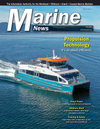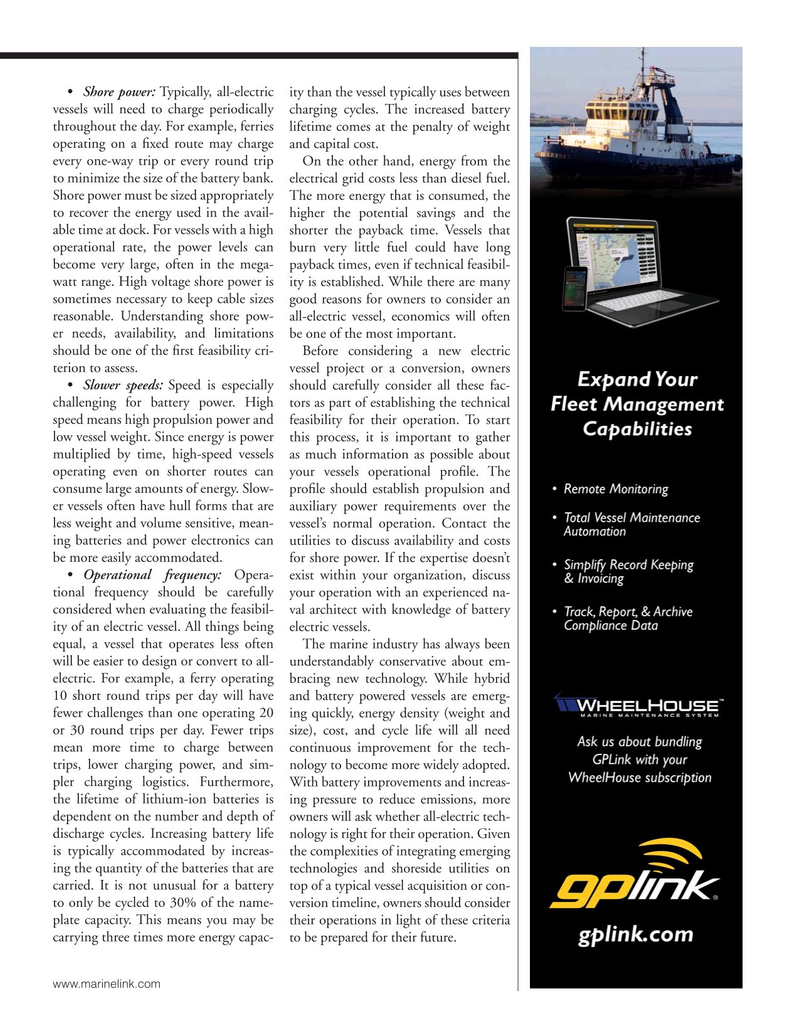
Page 21: of Marine News Magazine (July 2020)
Propulsion Technology
Read this page in Pdf, Flash or Html5 edition of July 2020 Marine News Magazine
UÊ-??ÀiÊ«?ÜiÀ\ÊTypically, all-electric ity than the vessel typically uses between vessels will need to charge periodically charging cycles. The increased battery throughout the day. For example, ferries lifetime comes at the penalty of weight operating on a ?xed route may charge and capital cost. every one-way trip or every round trip On the other hand, energy from the to minimize the size of the battery bank. electrical grid costs less than diesel fuel.
Shore power must be sized appropriately The more energy that is consumed, the to recover the energy used in the avail- higher the potential savings and the able time at dock. For vessels with a high shorter the payback time. Vessels that operational rate, the power levels can burn very little fuel could have long become very large, often in the mega- payback times, even if technical feasibil- watt range. High voltage shore power is ity is established. While there are many sometimes necessary to keep cable sizes good reasons for owners to consider an reasonable. Understanding shore pow- all-electric vessel, economics will often er needs, availability, and limitations be one of the most important.
should be one of the ?rst feasibility cri- Before considering a new electric terion to assess. vessel project or a conversion, owners
UÊ-?ÜiÀÊëii`Ã\ Speed is especially should carefully consider all these fac- challenging for battery power. High tors as part of establishing the technical speed means high propulsion power and feasibility for their operation. To start low vessel weight. Since energy is power this process, it is important to gather multiplied by time, high-speed vessels as much information as possible about operating even on shorter routes can your vessels operational pro?le. The consume large amounts of energy. Slow- pro?le should establish propulsion and er vessels often have hull forms that are auxiliary power requirements over the less weight and volume sensitive, mean- vessel’s normal operation. Contact the ing batteries and power electronics can utilities to discuss availability and costs be more easily accommodated. for shore power. If the expertise doesn’t
UÊ"«iÀ>Ì???>ÊvÀiµÕi?VÞ\ Opera- exist within your organization, discuss tional frequency should be carefully your operation with an experienced na- considered when evaluating the feasibil- val architect with knowledge of battery ity of an electric vessel. All things being electric vessels. equal, a vessel that operates less often The marine industry has always been will be easier to design or convert to all- understandably conservative about em- electric. For example, a ferry operating bracing new technology. While hybrid 10 short round trips per day will have and battery powered vessels are emerg- fewer challenges than one operating 20 ing quickly, energy density (weight and or 30 round trips per day. Fewer trips size), cost, and cycle life will all need mean more time to charge between continuous improvement for the tech- trips, lower charging power, and sim- nology to become more widely adopted. pler charging logistics. Furthermore, With battery improvements and increas- the lifetime of lithium-ion batteries is ing pressure to reduce emissions, more dependent on the number and depth of owners will ask whether all-electric tech- discharge cycles. Increasing battery life nology is right for their operation. Given is typically accommodated by increas- the complexities of integrating emerging ing the quantity of the batteries that are technologies and shoreside utilities on carried. It is not unusual for a battery top of a typical vessel acquisition or con- to only be cycled to 30% of the name- version timeline, owners should consider plate capacity. This means you may be their operations in light of these criteria carrying three times more energy capac- to be prepared for their future.
www.marinelink.com

 20
20

 22
22
